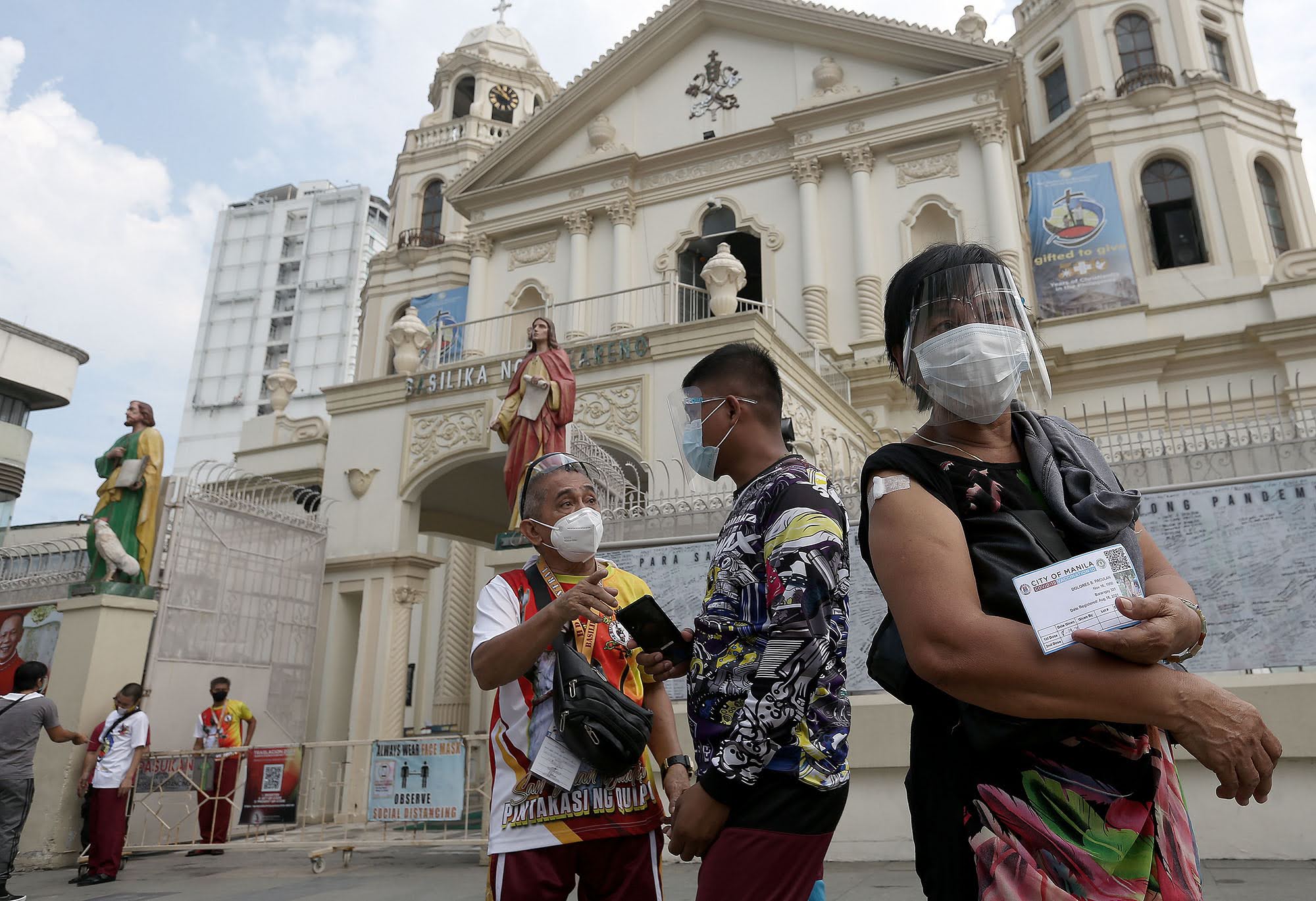
(FILE) FAITHFUL’S PASS A church worker asks for a vaccination card from people who wish to go inside Quiapo Church in Manila on Thursday as a new system of pandemic restrictions takes effect. Metro Manila is under alert level 4, which limits the crowd inside religious venues to only 10 percent of their capacity. —RICHARD A. REYES
MANILA, Philippines — More business establishments will be allowed to open and mobility restrictions relaxed when the National Capital Region (NCR) is placed under Alert Level 3 from Oct. 16 to Oct. 31.
Presidential spokesperson Harry Roque said on Wednesday that the Inter-Agency Task Force for the Management of Emerging Infectious Diseases (IATF) has approved the recommendation to place Metro Manila under the less restrictive quarantine status from the current Alert Level 4.
According to new guidelines on the pilot implementation of the alert level system in NCR dated Oct. 13, intrazonal and interzonal travel will be allowed, subject to reasonable restrictions based on age and comorbidities as may be determined by local government units (LGUs), which should not be as strict as those prescribed under Alert Level 4.
The new guidelines allow establishments or activities at only a maximum of 30 percent indoor venue capacity for fully vaccinated individuals and 50 percent for outdoors.
These include places for meetings, incentives, conferences, and exhibitions; social events, such as birthday parties, wedding receptions, and family reunions; tourist attractions; amusement parks; recreational venues, such as internet cafes, billiard halls, arcades, bowling alleys, and swimming pools; cinemas; in-person religious gatherings; dine-in services; personal care establishments, such as barbershops, salons, and spas, including home service options; fitness studios; venues for noncontact sports, and film, music, and television production.
All workers and employees of these establishments must be fully vaccinated against COVID-19 and the LGU where the activities may take place should not object to them.
Unlike in Alert Level 4, under Alert Level 3, vaccination status will no longer be determined in dine-in restaurants, personal care establishments, gyms, and worship areas.
However, several establishments and activities characterized as high-risk for transmission will remain restricted under Alert Level 3. These include face-to-face classes for basic education, except those previously approved by the IATF; contact sports, except those conducted under a bubble-type setup; fairs and playgrounds; venues with live performers and audiences, such as karaoke bars and concert halls; casinos and other gaming establishments, and gatherings in residences with individuals not belonging to the same household.
Relaxed travel rules
The IATF also relaxed the rules for arriving passengers from abroad effective Oct. 14.
For fully vaccinated foreign nationals, a negative RT-PCR test should be taken within 72 hours prior to the departure from the country of origin. Upon arrival, no more facility-based quarantine will be required.
Fully vaccinated Filipinos, on the other hand, can choose facility-based quarantine until the release of a negative RT-PCR test taken in the quarantine facility upon arrival, or no facility-based quarantine after getting a negative RT-PCR test within 72 hours prior to departure from the country of origin.
To validate their vaccination status, travelers may present either their VaxCertPH digital certificate, International Certificates of Vaccination or Prophylaxis (ICV) issued by the Bureau of Quarantine or the World Health Organization (WHO), or the national digital certificate of the foreign country where they were vaccinated.
New cases declining
For those vaccinated abroad, they may present WHO-issued ICV or the national digital certificate of their country, but only if it has recognized VaxCertPH under a reciprocal agreement.
The easing of restrictions followed the improving COVID-19 situation. On Wednesday, the Department of Health (DOH) said it logged 7,181 new infections, bringing the total tally in the country to 2,690,455 cases.
It was the third straight day that cases were less than 9,000 and the lowest since Aug. 4, when there were 7,342 cases logged.
However, the DOH said in its daily case bulletin that the relatively low numbers were due to lower laboratory output on Monday. In the same case bulletin, the DOH said there remained 82,411 active cases, or currently sick individuals, of which 75.3 percent were mild. The death toll rose by 173 to 40,069.
The positivity rate in the country was at 14.2 percent, which meant 7,725 of the 40,323 individuals tested on Monday were positive for COVID-19.
Backed by data
The DOH also said that 67 percent of all ICU beds and 52 percent of all COVID-19 ward beds were currently occupied, while 52 percent of all isolation beds and 49 percent of all mechanical ventilators were in use.
The quarantine easing has been pushed by the private sector, particularly for this last quarter of 2021.
“We have been talking to the DOH and the OCTA group as we look into the data of COVID cases. We are now experiencing a downward trend as Malaysia and Thailand, and we believe that this should be considered by the government, and [let us] open up more this fourth quarter,” Presidential Adviser for Entrepreneurship Joey Concepcion said in a statement on Wednesday.
Concepcion wants the government to allow 50 percent or even 70 percent indoor capacity for restaurants and personal care services for fully vaccinated customers.
He is also appealing for the reopening of other industries, such as cinemas, skin clinics, and wellness spas, for the fully vaccinated across all alert levels. Based on the government’s quarantine criteria, these industries are allowed to operate only under alert level 2. —With reports from Patricia Denise M. Chiu and Roy Stephen C. Canivel